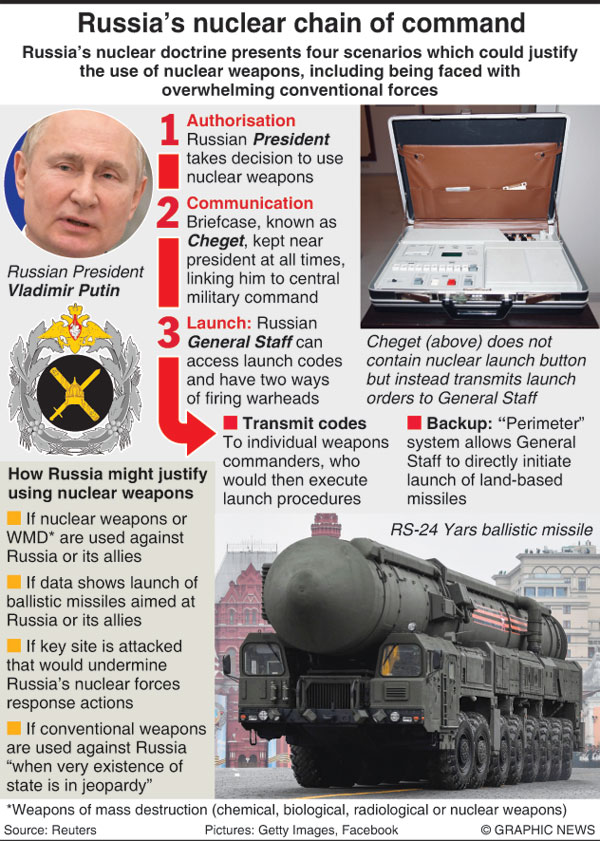Sunday Times 2
Nuclear war: How realistic is Putin’s nuclear threat?
Arguably frustrated by the lack of progress in his war on Ukraine, President Vladimir Putin has put Russia’s deterrent weapons – including its nuclear arms – on alert.
Since this provocation, the question has become all the more critical as to how many nuclear weapons Russia possesses and whether these could be indeed a realistic option for Putin.
“Putin is using his nuclear arsenal in this way because it is a tool he has, one that is mysterious and utterly terrifying,” Dakota S Rudesill, associate professor at Mershon Center for International Security Studies at Ohio State University, told Al Jazeera.
Moreover, the resistance the Russians have met in Ukraine so far has played a pivotal role in the decision, he said.
“Putin is reaching for it at this point because the war is probably not going as well as he anticipated. He wants to change the game and regain the initiative, wants his adversaries to be off-balance and frightened, wondering how he might escalate next and against whom,” Rudesill added.
However, one can also argue that Putin’s announcement was somewhat of a strategic mistake, said Alexander Lanoszka, assistant professor at the department of political science at the University of Waterloo.
“It seemed that it was an inevitable tactic played too early. For Putin, this might be problematic because future threats might not be believed. The United States, NATO, and the EU do not appear to be too fazed by it because we have observed no changes in the US, French, or British nuclear operations,” Lanoszka said.
Vast arsenal
Besides nuclear weapons, the Russian deterrent includes a massive arsenal of ballistic missiles with conventional warheads, modern cruise and short-range missiles, and hypersonic weapons.
However, it is particularly its nuclear capacity that makes Russia a force to be reckoned with.
“The Russian nuclear arsenal is vast insofar as estimates of it hold that it has 14,000 nuclear weapons in storage. That said, the majority of these weapons are not immediately usable. Closer to reality, Russia has over 2,400 strategic nuclear weapons, with the majority of them tied to the intercontinental ballistic missile force,” Lanoszka told Al Jazeera.
“Russia has an estimated 1,600 deployed tactical nuclear weapons… The plurality of these tactical weapons would be delivered from the sea, but many others would be delivered by the air or even by ground.”
Its stockpile makes Russia the largest nuclear power in the world, closely followed by the United States. The two together possess about 93 percent of all nuclear weapons globally.
The US possesses 3,750 active and inactive nuclear warheads with an estimated 150 at various sites in Europe.
The United Kingdom has a sea-based deterrent that has expanded to about 225 nuclear warheads, about half of which are operationally available on four submarines.
At any given moment, one-third or so are on active deployment. France has a nuclear stockpile of about 300 nuclear weapons, said Lanoszka.
This discrepancy in numbers is the reason why observers are pointing to gaps in NATO’s deterrent posture.
The sheer number of nuclear warheads available globally becomes even more terrifying when looking at how swiftly they can be launched.
“According to public sources, US intercontinental ballistic missiles [ICBMs] can fire within one to five minutes of an order by the president, and US submarine ballistic missiles [SLBM] can fire within about 15 minutes. The Russian system may have similar responsiveness,” said Rudesill.
However, there has been speculation on Russia’s nuclear modus operandi.
“For many decades, there has been debate in the West about whether the Soviet Union built a system that would allow for the automated launch of nuclear weapons in the event that the Soviet leadership was decapitated,” Rudesill said.
Nonetheless, despite Putin’s rhetoric, a nuclear war between Russia and NATO remains unlikely, Lanoszka argued.
‘Threat remains low’
“Keep in mind that Putin’s recent announcement most relates to staffing at various nuclear command and control centres. It does not yet appear that strategic and nonstrategic forces have changed their posture. The risk of nuclear weapons use is obviously elevated relative to normal circumstances, but the threat remains low for now.”
The primary reason that has prevented any nuclear attacks in the past is mutual assured destruction (MAD), a doctrine of military strategy and national security policy in which a full-scale use of nuclear weapons by two or more opposing sides would cause the complete annihilation of both the attacker and the defender.
“Use of a nuclear weapon by Russia is still highly unlikely because MAD remains the current state of affairs among the major nuclear powers in their deterrence relationships. However, thanks to Putin’s reckless statement and alert, nuclear use is now more likely than at any point since the Cold War. Nuclear use may be more likely than at any point since the Cuban Missile Crisis,” said Rudesill.
Moreover, there is still Putin’s persona to consider, said Erika Simpson, professor of international politics at Western University, president of the Canadian Peace Research Association, and the author of NATO and the Bomb.
“Putin’s threat to use nuclear weapons over Ukraine is crazy. Is he a madman? Has he lost his mind over the last two years, isolated from his family due to COVID? It looks like it. And nuclear deterrence does not work with an irrational madman,” Simpson told Al Jazeera.
“MAD is supposed to apply – but we did not expect Putin to invade a sovereign country and put Russian forces at risk with over 4,200 casualties already. Putin is risking soldiers’ lives, like pawns in a chess game… These factors make it impossible for nuclear deterrence to work properly as it requires rational decision-makers, as we learned from the 1962 Cuban missile crisis,” she said.
“A nuclear attack at the tactical level may be possible, but then a dangerous MAD escalation will ensue.”
Courtesy Al Jazeera


